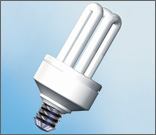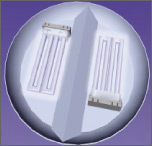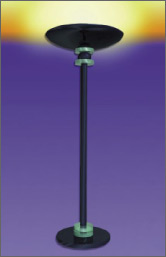Lighting

Compact Fluorescent Bulbs—A Bright Idea! Compact fluorescent bulbs are four times more energy efficient than incandescent bulbs and provide the same light levels.

Save Energy and More
Halogen lamps generate excessive heat that can create fire hazards. Use compact fluorescent lights in your torchieres or better yet, buy a torchiere designed for compact fluorescent bulbs.

Making improvements to your lighting is one of the fastest ways to cut your energy bills. An average household dedicates 11% of its energy budget to lighting. Using new lighting technologies can reduce lighting energy use in your home by 50% to 75%. Advances in lighting controls offer further energy savings by reducing the amount of time lights are on but not being used.
Indoor Lighting
Use tube fluorescent and energy efficient compact fluorescent lights (CFLs) in fixtures throughout your home to provide high-quality and high-efficiency lighting. Fluorescent lamps are much more efficient than incandescent (standard) bulbs and last about 4 to 10 times longer.
Today's CFLs offer brightness and color rendition that is comparable to incandescent lights. Although fluorescent and compact fluorescent lamps cost a bit more than incandescent bulbs, they pay for themselves by saving energy over their lifetime. CFL fixtures are now available that feature dimmers and operate much like incandescent fixtures.
Indoor Lighting Tips
- Look for the ENERGY STAR label when purchasing these products.
- Turn off the lights in any room you're not using, or consider installing timers, photo cells, or occupancy sensors to reduce the amount of time your lights are on.
- Use task lighting; instead of brightly lighting an entire room, focus the light where you need it. For example, use fluorescent under-cabinet lighting for kitchen sinks and countertops under cabinets.
- Consider three-way lamps; they make it easier to keep lighting levels low when brighter light is not necessary.
- Use 4-foot fluorescent fixtures with reflective backing and electronic ballasts for your workroom, garage, and laundry areas.
- Consider using 4-watt minifluorescent or electro-luminescent night lights. Both lights are much more efficient than their incandescent counterparts. The luminescent lights are cool to the touch.
- Use CFLs in all the portable table and floor lamps in your home. Consider carefully the size and fit of these systems when you select them. Some home fixtures may not accommodate some of the larger CFLs.
- Recessed downlights (also called recessed cans) are now available that are rated for contact with insulation (IC rated), are designed specifically for pin-based CFLs, and can be used in retrofits or new construction.
- Take advantage of daylight by using light-colored, loose-weave curtains on your windows to allow daylight to penetrate the room while preserving privacy. Also, decorate with lighter colors that reflect daylight.
- If you have torchiere fixtures with halogen lamps, consider replacing them with compact fluorescent torchieres. Compact fluorescent torchieres use 60% to 80% less energy, can produce more light (lumens), and do not get as hot as the halogen torchieres. Halogen torchieres are a fire risk because of the high temperature of the halogen bulb.
Outdoor Lighting
Many homeowners use outdoor lighting for decoration and security. When shopping for outdoor lights, you will find a variety of products, from low-voltage pathway lighting to motion-detector floodlights. Some stores also carry lights powered by small photovoltaic (PV) modules that convert sunlight directly into electricity; consider PV-powered lights for areas that are not close to an existing power supply line.
Outdoor Lighting Tips
- Use outdoor lights with a photocell unit or a motion sensor so they will turn on only at night or when someone is present. A combined photocell and motion sensor will increase your energy savings even more.
- Turn off decorative outdoor natural gas lamps; just eight such lamps burning year-round use as much natural gas as it takes to heat an average-size home during an entire winter.
- Exterior lighting is one of the best places to use CFLs because of their long life. If you live in a cold climate, be sure to buy a lamp with a cold weather ballast since standard CFLs may not work well below 40°F.
- Also consider high-intensity discharge (also called HID) or low-pressure sodium lights.
















